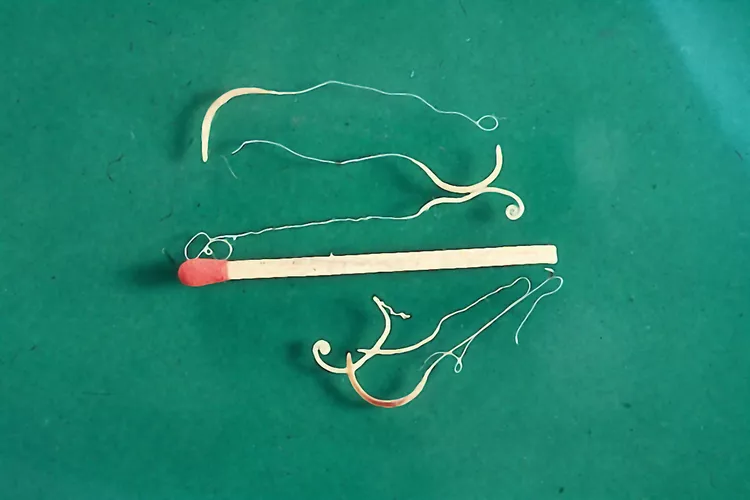Whipworms in Dogs

Whipworms are intestinal parasites that are relatively common in dogs. The medical term for a whipworm infestation is "trichuriasis." There are a variety of Trichuris species that affect different host species. The Trichuris vulpis parasite is often transmitted to dogs after they ingest soil contaminated with feces from infected dogs.
Whipworms are small worms, reaching a maximum size of 2 to 3 inches. They have a thin, whip-like front end and a thicker back end. The whipworms attach themselves to the walls of the large intestine, feeding on blood.
If your dog only has a small infestation of whipworms, it may not have any symptoms. Heavy infestations, however, usually cause diarrhea, weight loss, and sometimes anemia. While whipworms can infect any dog, they can potentially be more serious in young dogs, senior dogs, or dogs with weakened immune systems.
What Are Whipworms?
Whipworms are one of the four common intestinal worms that infect dogs. The other three are tapeworms, roundworms, and hookworms.
Whipworms have a simple life cycle; their eggs are passed in the dog's feces, and under ideal conditions, whipworm eggs can mature and become capable of causing infection after about two to four weeks in the environment. They are quite resistant to heat and dry conditions and can remain viable outside a host for as long as five years.
Once the eggs are ingested by a dog (for example, when a dog is grooming itself or eating things off the ground), they hatch in the dog's small intestine.
Eventually, the larvae move to the large intestine, taking about 11 weeks to become mature adults. They are then capable of producing more eggs, which then pass to the environment through the dog's stool, thus starting the cycle all over again.
Symptoms of Whipworms in Dogs
In dogs with light infections, there are usually no symptoms. As an infection intensifies, inflammation of the large intestine can result, and any of the following symptoms may appear.
Dogs with heavy loads of whipworms usually develop diarrhea, which can become chronic, leading to weight loss and dehydration. Often, the diarrhea is bloody or gooey. The intestinal inflammation can make it painful for the dog to pass feces, and you might notice your dog straining or crying while having a bowel movement.
Very heavy infestations can cause the dog to become anemic, meaning the dog has too few red blood cells. This can cause the dog to be fatigued or weak, and you might notice your dog's gums are paler than normal.
Rarely, whipworm infections cause a syndrome similar to Addison's disease, with periodic episodes of weakness and electrolyte imbalance, along with the typical symptoms of diarrhea. The mechanism of this effect is not understood, however.
What Causes Whipworms in Dogs?
The cause of a whipworm infection is the dog ingesting viable whipworm eggs from the soil. This can happen when a dog eats something off the ground, or if a dog gets whipworm eggs on its fur and then grooms itself. Once the dog has ingested the eggs, they mature within the dog's intestinal system.
How Vets Diagnose Whipworms in Dogs
The eggs of whipworms are too small to be seen with the naked eye, but they can be detected in a stool sample under the microscope. The test process is called fecal flotation. Unlike roundworms and hookworms, however, female whipworms only produce eggs intermittently, so the eggs can be difficult to catch on fecal tests. Repeated tests may be necessary, and if a whipworm infection is suspected, it is common to treat for whipworms even if eggs are not found.
How to Treat Whipworms in Dogs
Many medications can be used to treat whipworms, and your vet can help you pick the right one. Whipworms are often resistant to some common dewormers, so the treatment may be a prescription that is new to you. Multiple treatments are usually recommended for best results, usually spaced four weeks apart for at least 3 months. Most dogs fully recover from a whipworm infection with treatment.
Since the eggs survive for a long time, the potential for reinfection from eggs that are left in the intestinal tract is significant. Your vet may recommend that you give your dog a parasite preventative every few months. Often, a heartworm preventative that also prevents whipworms is prescribed.
Prognosis for Dogs With Whipworms
While it might take multiple treatments to completely eradicate whipworms, your dog should recover entirely once the worms are gone.
How to Prevent Whipworms in Dogs
If your dog has been diagnosed with whipworms, take care to clean any surfaces that may be infested. It is important to promptly remove pet waste, which could contain eggs. If your dog frequently defecates in a certain area in your yard, it may be beneficial to replace any gravel, wood chips, or other material in the area that is hard to clean.
While it can be difficult to entirely prevent your dog from eating things off the ground, do your best to keep your dog away from areas where you know it is likely to graze. Brush and bathe your dog regularly to help remove eggs from its fur.
In areas where whipworms are common, your veterinarian might recommend that you keep your dog on a regular schedule of heartworm preventative that is also effective against whipworms to reduce the risk of reinfection.
Are Whipworms Contagious to Humans?
The canine whipworm, Trichuris vulpis, very rarely infects humans, although it can infect other dogs in your home. There are also species of whipworms that mostly infect cats. However, animal whipworms are not considered a significant human health risk. There is a species of whipworm, Trichuris trichuria, that does infect humans, though.